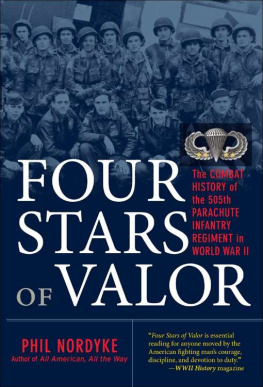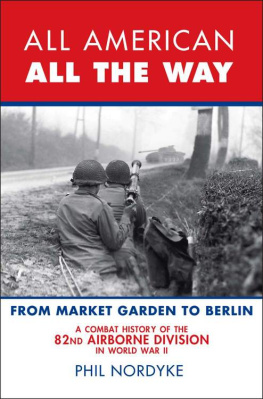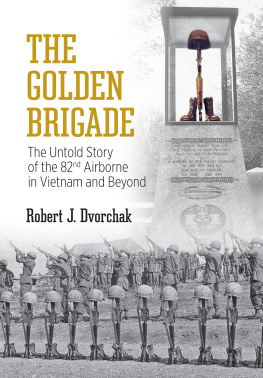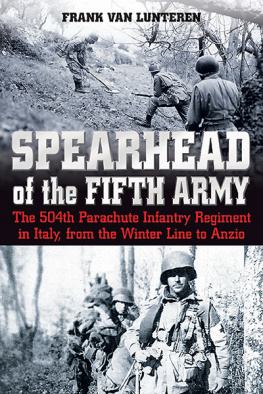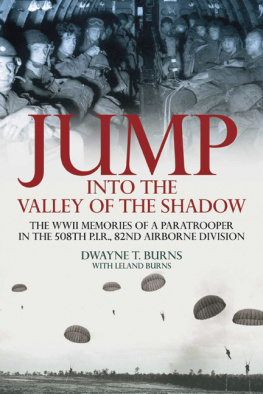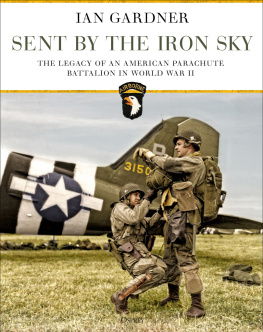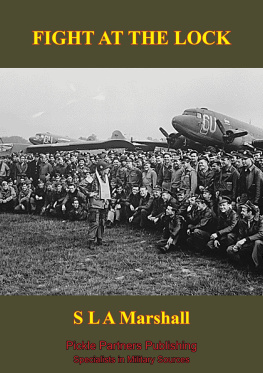FOUR
STARS
OF
VALOR
THE COMBAT HISTORY OF
THE 505TH PARACHUTE INFANTRY REGIMENT
IN WORLD WAR II
PHIL NORDYKE

CONTENTS
ACKNOWLEDGMENTS
I am indebted to many individuals and groups for their direct and indirect contributions to the completion of this project. First, I want to thank my family, particularly my wife, Nancy, for her understanding during my long hours of work, doing jobs around the house that should be my responsibility, as well as editing and proofreading. My sons, Jason and Robert, as well as my daughter, Amy, have been supportive, despite the time my writing has taken away from activities with each of them.
My heartfelt thanks go to my literary agent, Ms. Gayle Wurst, Princeton International Agency for the Arts, who did a superb job of promoting the book project and negotiating on my behalf.
Mr. Richard Kane, one of the most respected editors in military publishing, deserves much credit and my sincere appreciation for having faith in my ability to write a regimental history. Tom Kailbourn did a great job of copy editing the book and getting it in shape for publication.
Phil Schwartzberg, the cartographer at Meridian Mapping, Minneapolis, Minnesota, produces the best maps in the business and I owe him my thanks for his superb work.
The research materials for the book came from several repositories and archives. I am indebted to a number of wonderful people who provided help in obtaining the information. The Cornelius Ryan Archives at Ohio University in Athens, Ohio, was a wealth of veterans accounts and documents relating to the Normandy and Holland campaigns. I want to thank Doug McCabe, Curator of Manuscripts, Robert E. and Jean R. Mahn Center for Archives and Special Collections, the Alden Library, Ohio University, for providing the large volume of materials referenced in this book.
I want to recognize and thank Martin K. A. Morgan, noted author, historian, and curator at the Eisenhower Center in New Orleans, Louisiana, who provided copies of oral history transcripts and written accounts from the centers archives.
I want to extend my gratitude to Dr. John Duvall, Museums Chief, and Betty Rucker, Collections Manager, who opened up the RidgwayGavin Archives at The 82nd Airborne Division War Memorial Museum at Fort Bragg, North Carolina, a rich source of primary documents for this book.
Ericka L. Loze, Librarian, Donovan Research Library, Fort Benning, Georgia, provided monographs of 505th Parachute Infantry Regiment veterans from the librarys massive collection. I owe her much.
Guy LoFaro and Normand E. Thomas were kind enough to locate and send materials from the U.S. Military History Institute and the U.S. Army Center of Military History, saving me a great deal of time and expense.
I appreciate very much the after-action report of the 307th Airborne Engineer Battalion in Normandy, provided by Brian Siddall.
My thanks to Father G. Thuring and Frank van den Bergh with the Liberation Museum in Groesbeek, Holland. They provided much information about the campaign in Holland. Their books and expertise helped correct several errors in my understanding of the battle for the Nijmegen bridges.
The veterans of the 505th RCT Association deserve the greatest credit and appreciation for making this book possible. I must begin by acknowledging the early support of the late Lieutenant General Jack Norton and Colonel Mark Alexander, as well as Colonel Ed Sayre. They encouraged and inspired me to write this book.
I owe an enormous debt to 505th PIR veteran Don Lassen and his Static Line magazine for so much of the contact information of the 505th RCT veterans.
There were individuals with each unit who helped me with contact information, who provided entres to others in their units, and who provided information about the units. The names are too numerous to mention without invariably omitting to thank one or more. To the more than five hundred veterans, friends, and families of the 505th RCT who contributed to the book, I owe the greatest appreciation. This book would not have been possible without the first person accounts of the veterans of the regimental combat team.
In some cases, I have made minor changes to some of the personal accounts, correcting grammatical and spelling errors, rearranged sentences to put the action in chronological order, or to omit repetitive or irrelevant information in long quotes, and to have consistency in unit designations, equipment, and other items. However, the first person accounts are always true to the veterans original words.
It is to all of the officers and men who served with the legendary 505th Regimental Combat Team during World War II that this book is dedicated.
INTRODUCTION
This is the remarkable story of the only parachute regiment to make four combat jumps, and one of the greatest fighting forces ever assembled. It was an incredible collection of men from many backgrounds, with many individual talents and skills, attracted by the adventure and danger of being a paratrooper.
From the rigorous selection process of the parachute school at Fort Benning to the grueling training in the heat of the Frying Pan, Alabama Area, and North Africaonly the most physically fit, mentally strong, and highly motivated of those who volunteered, remained with the regiment. Under the command of one of the pioneers of airborne warfare and one of World War IIs greatest commanders, James M. Gavin, the 505th Parachute Infantry Regiment (PIR) was arguably the toughest, best-trained regiment that the United States Army has ever fielded. General Matthew B. Ridgway, who commanded both the 82nd Airborne Division and the XVIII Airborne Corps, which included the 101st and 17th Airborne Divisions, stated, I have no doubt that, based on its record, the 505 was the best parachute regiment to come out of World War II.
Gavins paratroopers made the first regimental combat jump in U.S. Army history, spearheading the invasion of Sicily. There, despite being badly scattered, they fought the powerful Hermann Gring Panzer Division to a standstill.
Barely two months later, they made a second parachute jump at Salerno, Italy, along with the 504th Parachute Infantry Regiment, saving the beachhead. The regiment led the drive north where it captured Naples, the first city in Europe liberated by Allied forces.
Eight months later, the regiment parachuted into Normandy, France, in the predawn hours of June 6, 1944some of the first Allied soldiers to land on Hitlers fortress Europe. Thanks to the great work of the units pathfinders, the 505th PIR was the only regiment to land on and close to their drop zone. There they liberated the first town in France, Ste.-Mre-glise, and held it against overwhelming numbers of enemy armor and infantry, preventing a counterattack on the forces landing at Utah Beach. The regiment spent thirty-three days in Normandy, spearheading the drive toward the port of Cherbourg, the severing of the Cotentin Peninsula at St.-Sauveur-le-Vicomte, and the capture of strategic hills near La Haye-du-Puits.
In little more than sixty days, the regiment made its fourth combat jump in fourteen months, when it spearheaded the Allied invasion of Holland, jumping in daytime, fifty-three miles behind German lines to provide a corridor for the British Second Armys drive to the Rhine River. Together with the 504th PIRs famed Devils in Baggy Pants, the regiment captured the massive highway bridge at Nijmegen. They fought for fifty-four days in Holland before being withdrawn to France for replacements and reorganization.
Next page
